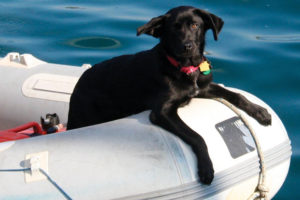 You and your furry friend are undoubtedly soaking in the August rays on the boat this season. Our pets bring joy into our lives, but we must be cognizant of their health, safety, and even their legal affairs on the water.
You and your furry friend are undoubtedly soaking in the August rays on the boat this season. Our pets bring joy into our lives, but we must be cognizant of their health, safety, and even their legal affairs on the water.
Many people don’t know that the sun is just as harmful to cats and dogs as it is to us. Pets can get a sunburn, heat stroke, and even skin cancer. Make sure you always have access to clean drinking water and shade in case they overheat. The next step might sound strange, but your dogs and cats would appreciate some sunscreen. Yes, their fur does protect the majority of their body, but any bare spots such as the nose, tip of their ears, belly, or balding patches can get irritated. Some short haired breeds also need sunscreen protection. There are a few companies that make sunscreen specifically for dogs such as the Epi-Pet Sunscreen Spray, which is recommended by the Banfield Veterinary Hospital of Portland, Oregon. The basic rule is that the sunblock should have a SPF of 15 or higher and it shouldn’t contain Zinc Oxide, which is common in many human sunscreens, but toxic to dogs and cats according to Banfield. More information is available at banfieldvet.com.
Basic safety should be considered as well. You might brag about how your pup can swim miles at a time, but a life jacket is a must for an extra-safe trip. Strap your dog into a specially made PFD before you go on your adventure in case they get tired in the water, and you get the added bonus of seeing your dog in a cute little life vest. Most cats do not prefer to swim, but Banfield recommends always having them on some sort of harness with a leash while they’re aboard. This can be tricky for a cat to get used to, but it allows you to know where they are at all times. Keeping cats in the cabin while underway may be a good move as well.
If your voyage involves entering Canada, you will need to get a rabies vaccination certificate from your veterinary clinic. This document shows that your four-legged pal has his or her vaccines and is rabies-free. You will need to present the certificate to the customs agents before entering Canada, just like you would with your passport. If your dog is less than eight months old, or your cat is less than three months old, you don’t need to get a certificate. More information can be found at Canada.ca.
Who wants to wake up at 0200 hours to row Fido to an unfamiliar shoreline to answer nature’s call? Storming to shore so your pet can use the bathroom can cause unnecessary stress, so create a small bathroom area just for them on your boat. For cats, this can be as simple as a small litter box. A cost-effective option is to place a fake grass pad in the box instead of liter and wash it off when needed to reuse it. For dogs, purchase puppy pads or a fake grass pad and place it on the deck.
If you follow these safety and travel tips, you and your furry friend will share memorable adventures this summer and for the many years ahead. Happy Boating!
The adorable pooch picture above is Ollie, a 3/4 black lab and 1/4 heeler mix. She boats with her humans April Wheldon and William Akan. Ollie has been living on her family’s boat since she was eight weeks old and loves the life!



1 comment
Taking out friend is a big responsibility. People just assume if a dog falls out they can swim, however they need to be treated with care. Bullfrog Marina actually has a mascot named Bear. Hes a famous in the delta. 🙂